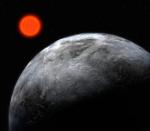 A planet 20 light years away is the first outside our solar system to be declared ‘habitable’ by scientists.
A planet 20 light years away is the first outside our solar system to be declared ‘habitable’ by scientists.
The rocky ‘exoplanet’ Gliese 581d meets key requirements for sustaining Earth-like life, including rainfall and possibly even watery oceans.
The planet orbits a red-dwarf star similarly called Gliese 581, on its outer fringes called the ‘Goldilocks zone’, where the temperature is not so hot that water boils away, nor so cold that water is perpetually frozen.
But even though it may be technically habitable, the Gliese 581d would not make a comfortable dwelling for humans.
Gravity is twice what is on Earth, doubling the weight of anyone standing on the surface, and the atmosphere is dense with carbon dioxide.
With a mass of at least 5.6 times that of Earth, Gliese 581d is classified as a ‘super-Earth’.
The discovery caught scientists by surprise because the planet was previously ruled out as a habitable country.
But a new computer model with the capacity to simulate extraterrestrial climates has confirmed that Gliese 581d really could harbour life, showing the prior assumption to be wrong.
“This discovery is important because it’s the first time climate modellers have proved that the planet is potentially habitable, and all observers agree that the exoplanet exists,” said Dr Robin Wordsworth, a member of the French team from the Institut Pierre Simon Laplace in Paris.
“If you look at the history of the search for habitable planets, there’s been at least two instances so far when scientists have announced that a habitable world has been discovered, only to have the claim contradicted later, either by climate experts or by other observers.”
On average, the light that Gliese 581d receives from its star has about 30 per cent of the intensity of sunlight on Earth.
While that temperature seems too cold to support liquid water, the atmosphere’s high production of greenhouse gases significantly heats the planet.
It may also be “tidally locked”, meaning that one side of it always faces the sun, which would give it permanent dayside and nightside.
More than 500 planets orbiting other stars have been recorded since 1995, detected mostly by a tiny wobble in stellar light.
Exoplanets are named after their star and listed alphabetically, in order of discovery.
Until now, the big interest in Gliese 581’s roster of planets focused on Gliese 581g.
It swept the headlines last year as ‘Zarmina’s World’, after its observers announced it had roughly the same mass as Earth’s and was also close to the ‘Goldilocks zone’.
But that discovery has since been discounted by many, with some experts suspecting the Gliese 581g may not even exist.

